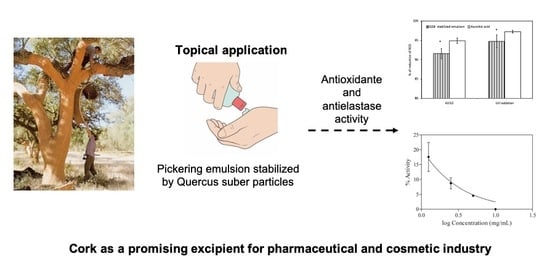Design and Characterization of a New Quercus Suber-Based Pickering Emulsion for Topical Application
Abstract
:1. Introduction
2. Materials and Methods
2.1. Materials
2.2. Methods
2.2.1. Quercus Suber Bark (QSB) Particle Size Distribution
2.2.2. Wettability Measurements of QSB Particles
2.2.3. Preparation and Characterization of Emulsions Stabilized by QSB Particles
2.2.4. Droplet Size Analysis
2.2.5. Optimization Studies
Identification of Quality Target Product Profile (QTPP) and Critical Quality Attributes (CQAs)
2.2.6. Risk Analysis of CQAs
2.2.7. Design of Experiments (DoE)
2.2.8. Stability Assessment of Optimized Formulation
2.2.9. In Vitro Studies
Cytotoxicity Assay
Anti-Oxidant Activity
Enzymatic Inhibition Assay
2.2.10. Physicochemical Characterization
2.2.11. In Vivo Compatibility and Sensorial Studies
Human Repeat Insult Patch Test (HRIPT)
Sensorial Analysis
2.2.12. Statistical Analysis
3. Results and Discussion
3.1. Formulation Studies
Quercus Suber Bark (QSB) Particle Size Distribution
3.2. Wettability Measurements of QBS Particles
3.3. Characterization of Emulsions Stabilized by QSB Particles
3.4. Optimization Studies
Risk Analysis of CQAs
3.5. Establishment of Design Space
3.5.1. Response Surface Analysis
3.5.2. Design Space
3.6. Final Formulation
Physicochemical Characterization
3.7. Stability Assessment of Optimized Formulation
3.8. In Vitro Studies
3.8.1. Cytotoxicity Assay
3.8.2. Anti-Oxidant and Anti-Elastase Activity
3.9. In Vivo Compatibility and Sensorial Studies
4. Conclusions
Author Contributions
Funding
Conflicts of Interest
References and Note
- Marto, J.; Ascenso, A.; Simões, S.; Almeida, A.J.; Ribeiro, H.M. Pickering emulsions: Challenges and opportunities in topical delivery. Expert Opin. Drug Deliv. 2016, 13, 1093–1107. [Google Scholar] [CrossRef]
- Ribeiro, H.M.; Morais, J.A.; Eccleston, G.M. Structure and rheology of semisolid o/w creams containing cetyl alcohol/non-ionic surfactant mixed emulsifier and different polymers. Int. J. Cosmet. Sci. 2004, 26, 47–59. [Google Scholar] [CrossRef] [PubMed]
- Bouyer, E.; Mekhloufi, G.; Rosilio, V.; Grossiord, J.L.; Agnely, F. Proteins, polysaccharides, and their complexes used as stabilizers for emulsions: Alternatives to synthetic surfactants in the pharmaceutical field? Int. J. Pharm. 2012, 436, 359–378. [Google Scholar] [CrossRef]
- Marto, J.; Baltazar, D.; Duarte, A.; Fernandes, A.; Gouveia, L.; Militão, M.; Salgado, A.; Simões, S.; Oliveira, E.; Ribeiro, H.M. Topical gels of etofenamate: In vitro and in vivo evaluation. Pharm. Dev. Technol. 2015, 20, 710–715. [Google Scholar] [CrossRef] [PubMed]
- Marto, J.; Gouveia, L.F.; Jorge, I.M.; Duarte, A.; Gonçalves, L.M.; Silva, S.M.C.; Antunes, F.E.; Pais, A.A.C.C.; Oliveira, E.; Almeida, A.J.; et al. Starch-based Pickering emulsions for topical drug delivery: A QbD approach. Colloid Surf. B: Biointerfaces 2015, 135, 183–192. [Google Scholar] [CrossRef] [PubMed]
- Marto, J.; Gouveia, L.F.; Gonçalves, L.; Chiari-Andréo, B.G.; Isaac, V.; Pinto, P.; Oliveira, E.; Almeida, A.J.; Ribeiro, H.M. Design of novel starch-based Pickering emulsions as platforms for skin photoprotection. J. Photochem. Photobiol. B: Biol. 2016, 162, 56–64. [Google Scholar] [CrossRef] [PubMed]
- Chevalier, Y.; Bolzinger, M.A. Emulsions stabilized with solid nanoparticles: Pickering emulsions. Colloid. Surf. A: Physicochem. Eng. Asp. 2013, 439, 23–34. [Google Scholar] [CrossRef]
- Matos, M.; Timgren, A.; Sjöö, M.; Dejmek, P.; Rayner, M. Preparation and encapsulation properties of double Pickering emulsions stabilized by quinoa starch granules. Colloid. Surf. A: Physicochem. Eng. Asp. 2013, 423, 147–153. [Google Scholar] [CrossRef]
- Binks, B.P. Particles as surfactants—Similarities and differences. Curr. Opin. Colloid Interface Sci. 2002, 7, 21–41. [Google Scholar] [CrossRef]
- Kaewsaneha, C.; Tangboriboonrat, P.; Polpanich, D.; Eissa, M.; Elaissari, A. Preparation of Janus colloidal particles via Pickering emulsion: An overview. Colloid. Surf. A: Physicochem. Eng. Asp. 2013, 439, 35–42. [Google Scholar] [CrossRef]
- Timgren, A.; Rayner, M.; Sjöö, M.; Dejmek, P. Starch particles for food based Pickering emulsions. Procedia Food Sci. 2011, 1, 95–103. [Google Scholar] [CrossRef] [Green Version]
- Marku, D.; Wahlgren, M.; Rayner, M.; Timgren, A. Characterization of starch Pickering emulsions for potential applications in topical formulations. Int. J. Pharm. 2012, 428, 1–7. [Google Scholar] [CrossRef] [PubMed]
- Rayner, M.; Marku, D.; Eriksson, M.; Dejmek, P.; Wahlgren, M. Biomass-based particles for the formulation of Pickering type emulsions in food and topical applications. Colloid. Surf. A: Physicochem. Eng. Asp. 2014, 458, 48–62. [Google Scholar] [CrossRef]
- Laredj-Bourezg, F.; Chevalier, Y.; Boyron, O.; Bolzinger, M.A. Emulsions stabilized with organic solid particles. Colloid. Surf. A: Physicochem. Eng. Asp. 2012, 413, 252–259. [Google Scholar] [CrossRef]
- Carriço, C.; Ribeiro, H.M.; Marto, J. Converting cork by-products to ecofriendly cork bioactive ingredients: Novel pharmaceutical and cosmetics applications. Ind. Crop Prod. 2018, 125, 72–84. [Google Scholar] [CrossRef]
- Jové, P.; Olivella, A.C.; Cano, L. Study of the variability in chemical composition of bark layers of Quercus Suber L. from different production areas. BioResources 2011, 6, 1806–1815. [Google Scholar] [CrossRef]
- Santos, S.; Pinto., P.; Silvestre, A.; Neto, C.P. Chemical composition and antioxidant activity of phenolic extracts of cork from Quercus suber L. Ind. Crop Prod. 2010, 31, 521–526. [Google Scholar] [CrossRef]
- Castola, V.; Marongiu, B.; Bighelli, A.; Floris, C.; Laï, A.; Casanova, J. Extractives of cork (Quercus suber L.): Chemical composition of dichloromethane and supercritical CO2 extracts. Ind. Crop Prod. 2005, 21, 65–69. [Google Scholar] [CrossRef]
- Subhashini, S.; Begum, S.F.M.; Rajesh, G. Antimicrobial characterisation combining spectrophotometric analysis of different oak species. Int. J. Herb. Med. 2016, 4, 32–35. [Google Scholar]
- Khennouf, S.; Benabdallah, H.; Gharzouli, K.; Amira, S.; Ito, H.; Kim, T.H.; Yoshida, T.; Gharzouli, A. Effect of Tannins from Quercus suber and Quercus coccifera Leaves on Ethanol–Induced Gastric Lesions in Mice. Int. J. Agric. Food Chem. 2003, 51, 1469–1473. [Google Scholar] [CrossRef] [PubMed]
- Coquet, C.; Bauza, E.; Oberto, G.; Berghi, A.; Farnet, A.M.; Ferré, E.; Peyronel, D.; Dal Farra, C.; Domloge, N. Quercus suber cork extract displays a tensor and smoothing effect on human skin: An in vivo study. Drugs Exp. Clin. Res. 2005, 31, 89–99. [Google Scholar] [PubMed]
- Marto, J.; Gonçalves, L.M.; Fitas, M.; Pinto, P.; Almeida, A.J.; Ribeiro, H.M. Safety assessment of starch–based personal care products: Nanocapsules and pickering emulsions. Toxicol. Appl. Pharm. 2018, 342, 14–21. [Google Scholar] [CrossRef] [PubMed]
- Marto, J.; Ascenso, A.; Gonçalves, L.M.; Gouveia, L.F.; Manteigas, P.; Pinto, P.; Oliveira, E.; Almeida, A.J.; Ribeiro, H.M. Melatonin-based Pickering emulsion for skin’s photoprotection. Drug Deliv. 2016, 23, 1594–1607. [Google Scholar] [CrossRef]
- Marzulli, F.N.; Maibach, H.I. Contact allergy: Predictive testing in man. Contact Dermat. 1976, 2, 1–17. [Google Scholar] [CrossRef] [Green Version]
- EC. Regulation (EC) No 1223/2009 of the European Parliament and of the Council of 30 November 2009 on Cosmetic Products; EC, Ed.; Official Journal of the European Union: Brussels, Belgium, 2009. [Google Scholar]
- Molina, J.M.; Narciso, J.; Weber, L.; Mortensen, A.; Louis, E. Thermal conductivity of Al-SiC composites with monomodal and bimodal particle size distribution. Adv. Mater. Res.-Switz. 2008, 480, 483–488. [Google Scholar] [CrossRef]
- Ruckenstein, E. Microemulsions, Macroemulsions, and the Bancroft Rule. Langmuir 1996, 12, 6351–6353. [Google Scholar] [CrossRef]
- Preziosi, V.; Perazzo, A.; Caserta, S.; Tomaiuolo, G.; Guido, S. Phase Inversion Emulsification. Chem. Eng. Trans. 2013, 32, 1585–1590. [Google Scholar] [CrossRef]
- International Conference on Harmonisation (ICH) of Technical Requirement for Registration of Pharmaceuticals for Human Use, Pharmaceutical Development, Q8 (R2). 2009.
- Lam, S.; Velikov, K.P.; Velev, O.D. Pickering stabilization of foams and emulsions with particles of biological origin. Curr. Opin. Colloid Interface Sci. 2014, 19, 490–500. [Google Scholar] [CrossRef]
- Lionberger, R.A.; Lee, S.L.; Lee, L.; Raw, A.; Lawrence, X.Y. Quality by Design: Concepts for ANDAs. Int. J. AAPS 2008, 10, 268–276. [Google Scholar] [CrossRef] [Green Version]
- Schmid-Wendtner, M.H.; Korting, H.C. The pH of the Skin Surface and Its Impact on the Barrier Function. Skin Pharmacol. Physiol. 2006, 19, 296–302. [Google Scholar] [CrossRef] [Green Version]
- Marcottea, M.; Hoshahilia, A.R.T.; Ramaswamy, H.S. Rheological properties of selected hydrocolloids as a function of concentration and temperature. Food Res. Int. 2001, 34, 695–703. [Google Scholar] [CrossRef]
- Zhong, L.; Oostrom, M.; Truex, M.J.; Vermeul, V.R.; Szecsody, J.E. Rheological behavior of xanthan gum solution related to shear thinning fluid delivery for subsurface remediation. Int. J. Hazard. Mater. 2013, 244–245, 160–170. [Google Scholar] [CrossRef] [PubMed]
- Mendes, P.R.S. Modeling the thixotropic behavior of structured fluids. J. Non-Newton Fluid Mech. 2009, 164, 66–75. [Google Scholar] [CrossRef]
- Rykaczewski, K.; Paxson, A.T.; Anand, S.; Chen, X.; Wang, Z.; Varanasi, K.K. Multimode Multidrop Serial Coalescence Effects during Condensation on Hierarchical Superhydrophobic Surfaces. Langmuir 2013, 29, 881–891. [Google Scholar] [CrossRef] [PubMed]
- OECD. Test No. 439: In Vitro Skin Irritation Reconstructed Human Epidermis Test Method: Reconstructed Human Epidermis Test Method; OECD Publishing: Paris, France, 2010. [Google Scholar]
- Murray, J.C.; Burch, J.A.; Streilein, R.D.; Iannacchione, M.A.; Hall, R.P.; Pinnell, S.R. A topical antioxidant solution containing vitamins C and E stabilized by ferulic acid provides protection for human skin against damage caused by ultraviolet irradiation. J. Am. Acad. Dermatol. 2008, 59, 418–425. [Google Scholar] [CrossRef]
- Lee, J.Y.; Yoon, J.W.; Kim, C.T.; Lim, S.T. Antioxidant activity of phenylpropanoid esters isolated and identified from Platycodon grandiflorum A. DC. Phytochemistry 2004, 65, 3033–3039. [Google Scholar] [CrossRef] [PubMed]
- Dönmez, I.E.; Hemming, J.; Willför, S. Bark extractives and suberin monomers from Arbutus andrachne and Platanus orientalis. BioResources 2016, 11, 2809–2819. [Google Scholar] [CrossRef]
- Gonzalez-Burgos, E.; Gomez-Serranillos, M.P. Terpene Compounds in Nature: A Review of Their Potential Antioxidant Activity. Curr. Med. Chem. 2012, 19, 5319–5341. [Google Scholar] [CrossRef] [PubMed]
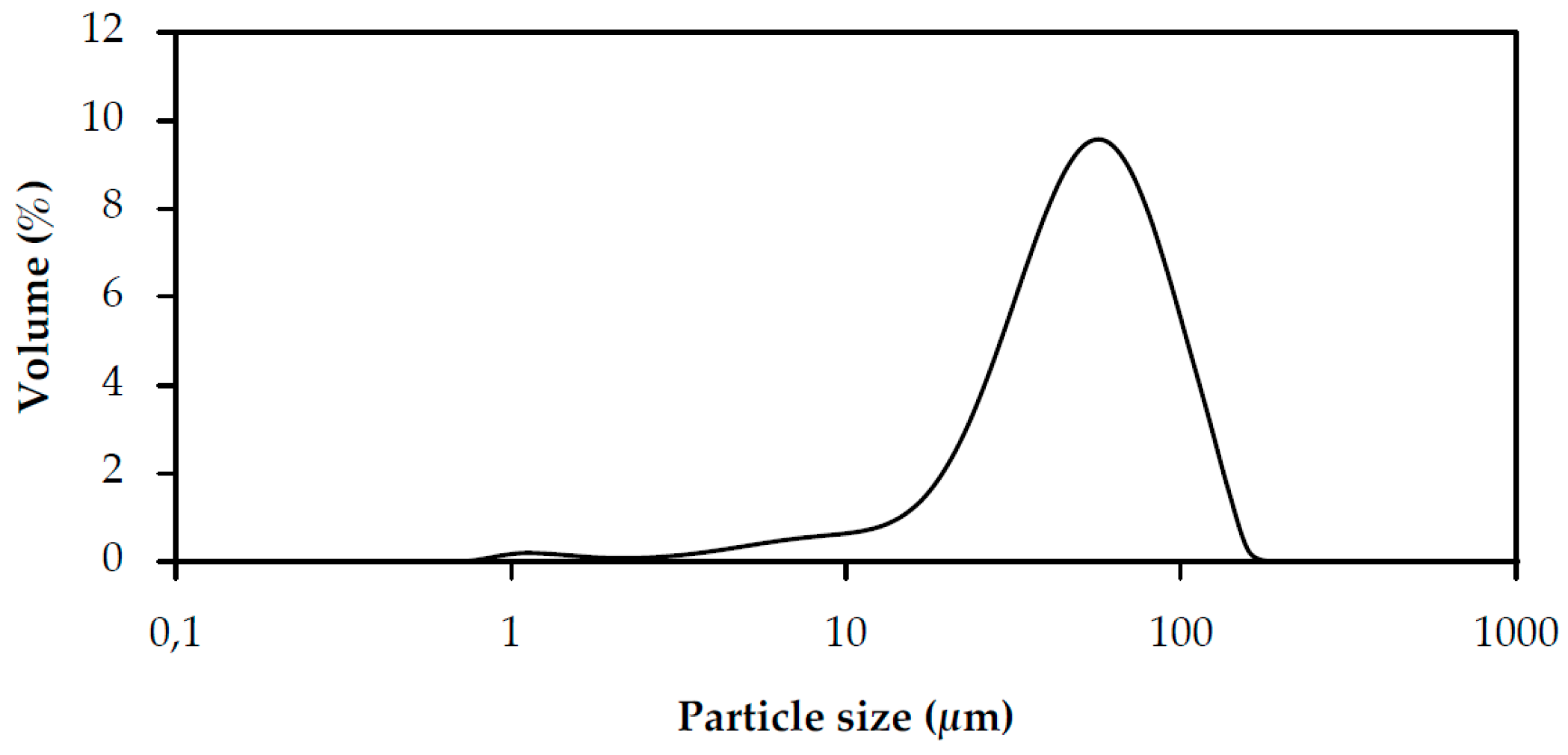

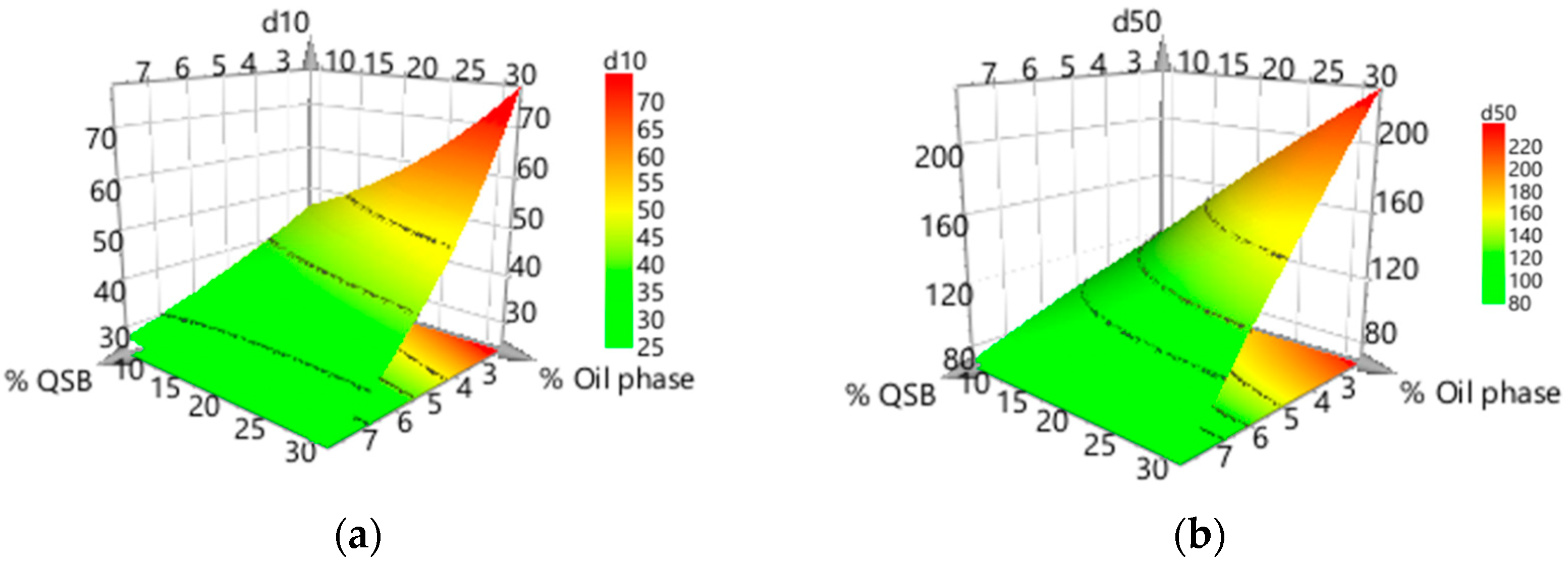
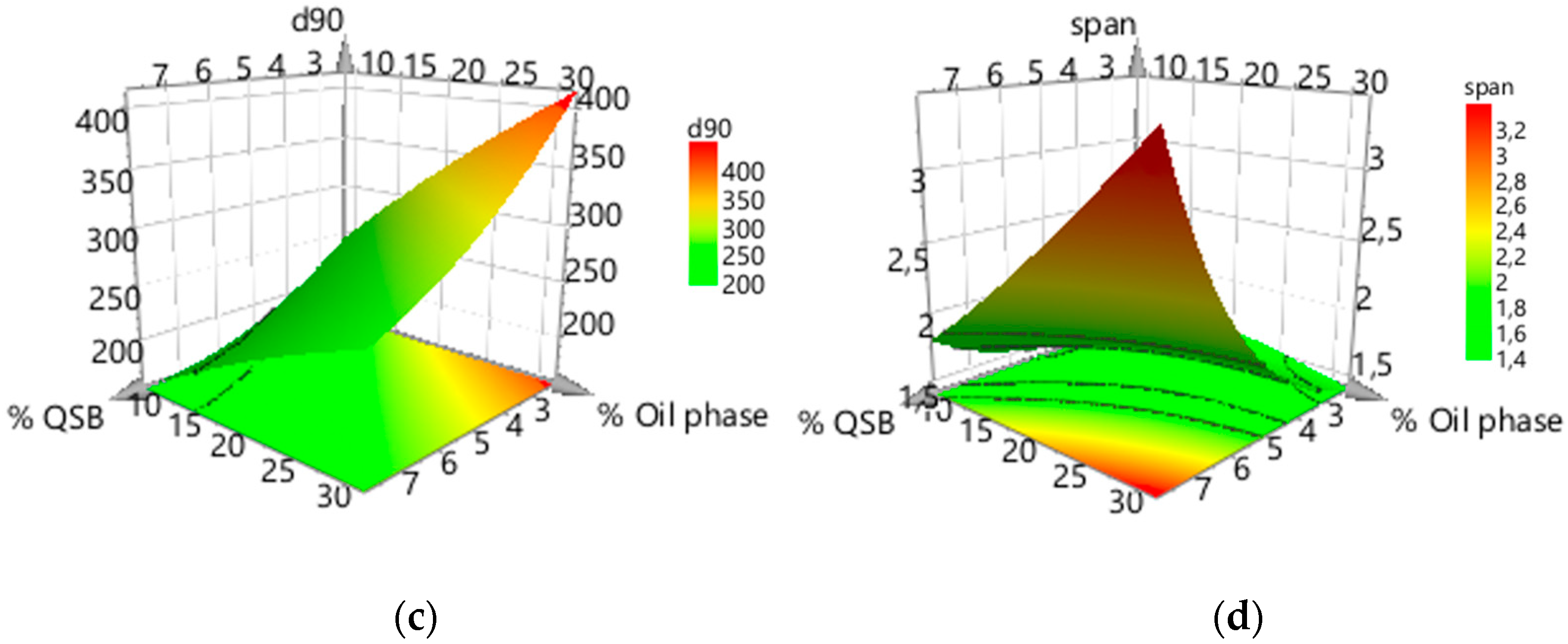
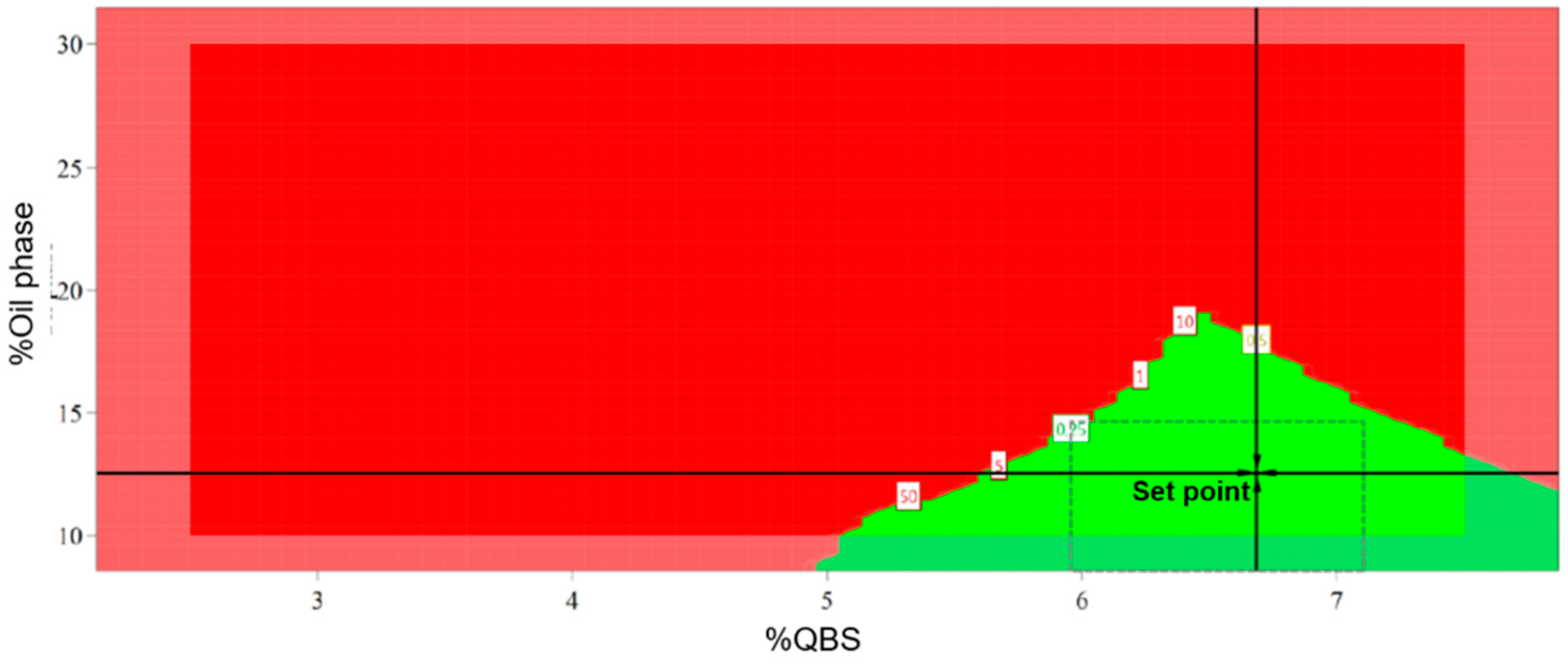
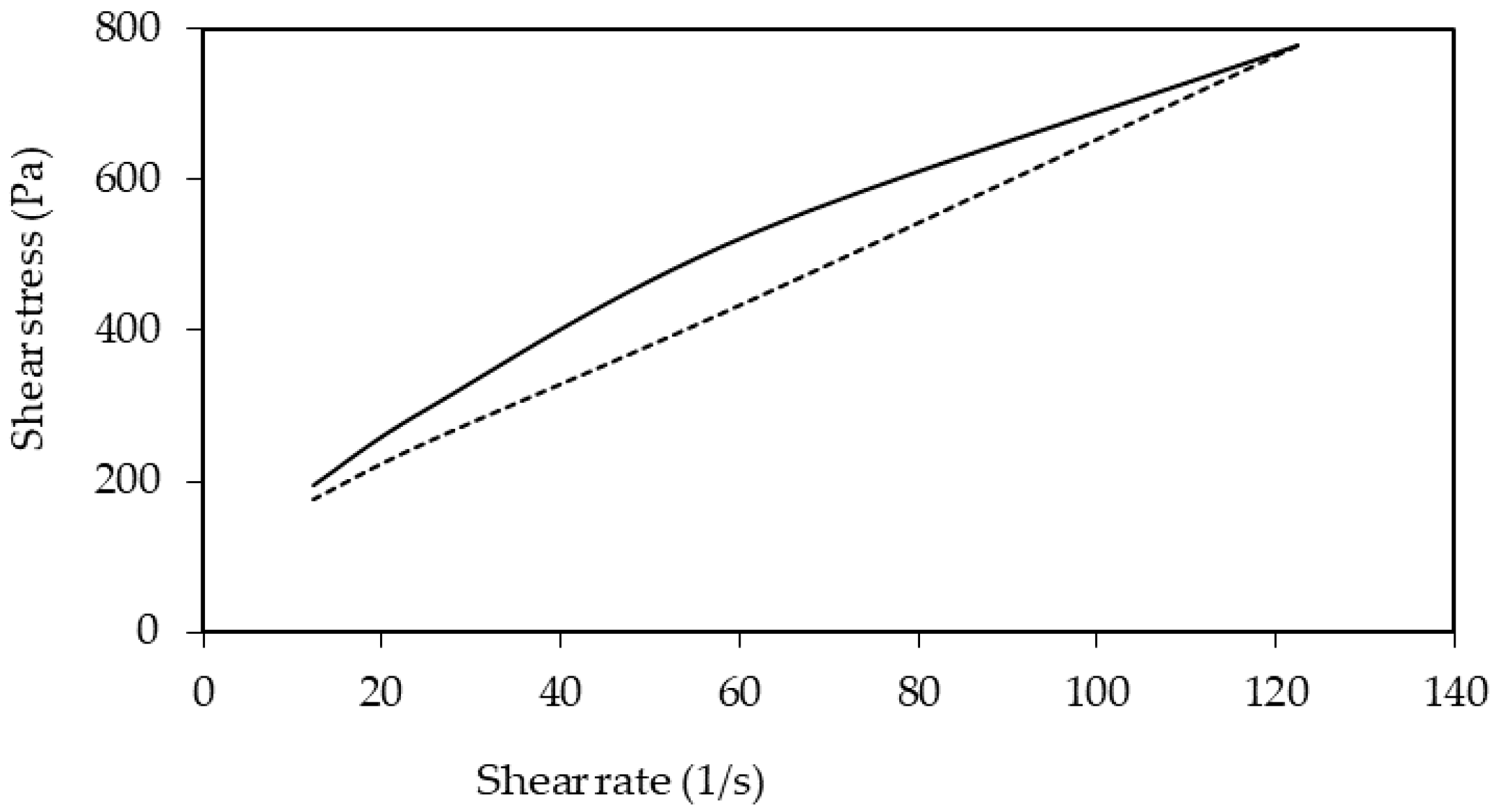
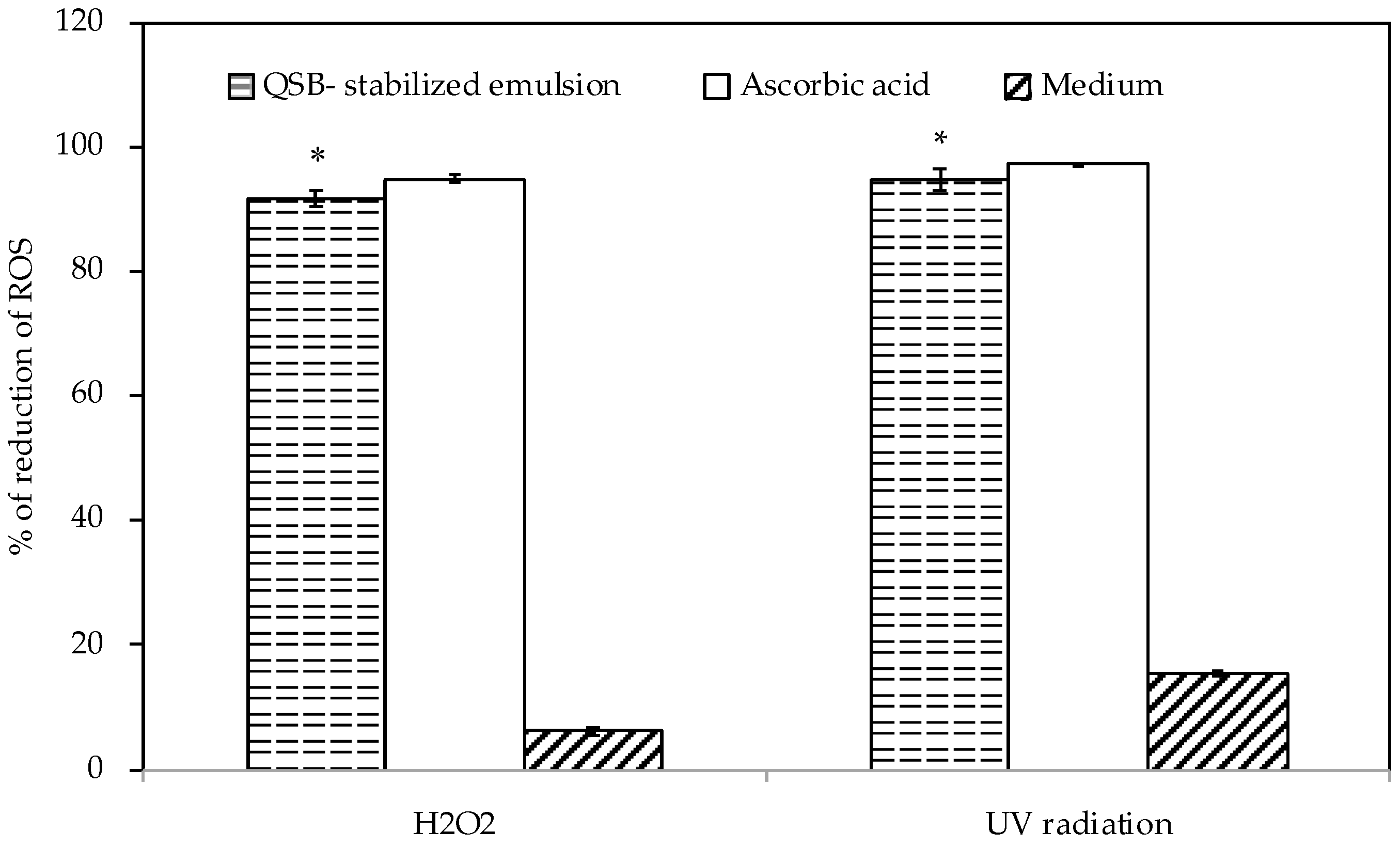
| QTPP Element | Target | Reference |
|---|---|---|
| Route of administration | Topical | [21] |
| Dosage form | Emulsion (Pickering emulsion) | [5] |
| Droplet size distribution: | [5] | |
| d(10)—30–50 µm d(50)—100–150 µm | ||
| d(90)—130–190 µm | ||
| Span—1.5–1.9 | ||
| Stability | Without separation of phases | [5] |
| In vitro studies | Efficacy: Anti-oxidant and anti-elastase activity Safety: Cytotoxicity assay | [15] |
| In vivo studies | Skin biocompatibility: Human repeat insult patch test (HRIPT) | [22] |
| Exp Name | Run Order | Design Matrix | Experimental Matrix for Formula Optimization | |||
|---|---|---|---|---|---|---|
| QSB | Oil phase | %QSB | %Oil phase | % Aq. Phase | ||
| N1 | 1 | −1 | −1 | 2.50 | 10.00 | 87.50 |
| N2 | 6 | 1 | −1 | 7.50 | 10.00 | 82.50 |
| N3 | 11 | −1 | 1 | 2.50 | 30.00 | 67.50 |
| N4 | 9 | 1 | 1 | 7.50 | 30.00 | 62.50 |
| N5 | 7 | −1.14744 | 0 | 2.13 | 20.00 | 77.87 |
| N6 | 10 | 1.14744 | 0 | 7.87 | 20.00 | 72.13 |
| N7 | 2 | 0 | −1.14744 | 5.00 | 8.53 | 86.47 |
| N8 | 8 | 0 | 1.14744 | 5.00 | 31.47 | 63.53 |
| N9 | 3 | 0 | 0 | 5.00 | 20.00 | 75.00 |
| N10 | 4 | 0 | 0 | 5.00 | 20.00 | 75.00 |
| N11 | 5 | 0 | 0 | 5.00 | 20.00 | 75.00 |
| Particles | Contact Angle (θ °) | ||||
|---|---|---|---|---|---|
| Water | CT | XC | Dimethicone | Cetyl Dimethicone | |
| QSB | 97.3 ± 0.3 | 0.0 ± 0.0 | 8.0 ± 2.4 | 25.2 ± 8.7 | 10.4 ± 11.8 |
| Batch | Droplet Size Distribution (μm) | |||
|---|---|---|---|---|
| Span | d10 | d50 | d90 | |
| T 0 days | ||||
| 1 | 1.6 ± 0.0 | 33.1 ± 0.2 | 88.4 ± 1.1 | 179.2 ± 2.7 |
| 2 | 1.7 ± 0.0 | 32.0 ± 0.3 | 87.3 ± 1.0 | 179.5 ± 2.8 |
| 3 | 1.6 ± 0.0 | 34.6 ± 0.2 | 90.7 ± 0.6 | 182.1 ± 1.3 |
| T 14 days | ||||
| 1 | 1.7 ± 0.0 | 30.1 ± 0.1 | 79.5 ± 0.5 | 161.2 ± 1.1 |
| 2 | 1.6 ± 0.0 | 32.3 ± 0.5 | 82.8 ± 3.2 | 161.6 ± 6.5 |
| 3 | 1.6 ± 0.0 | 29.5 ± 0.1 | 76.7 ± 0.4 | 153.0 ± 0.7 |
| T 30 days | ||||
| 1 | 1.6 ± 0.0 | 31.2 ± 0.1 | 82.90.4 | 166.3 ± 1.2 |
| 2 | 1.6 ± 0.0 | 34.5 ± 0.2 | 91.1 ± 0.6 | 180.6 ± 1.2 |
| 3 | 1.7 ± 0.0 | 30.1 ± 0.1 | 80.9 ± 0.4 | 164.4 ± 1.3 |
| Formula Parameters | d(10) | d(50) | d(90) | Span | ||||
|---|---|---|---|---|---|---|---|---|
| Coeff | ± SE | Coeff | ± SE | Coeff | ± SE | Coeff | ± SE | |
| K | 1.58 | 0.03 | 126.27 | 3.74 | 255.02 | 7.61 | 0.23 | 0.01 |
| QSB | −0.16 | 0.02 | −46.02 | 2.65 | −52.63 | 5.39 | 0.09 | 0.01 |
| Oil | NS | NS | 23.81 | 2.65 | 60.74 | 5.39 | 0.05 | 0.01 |
| Oil*Oil | NS | NS | NS | NS | NS | NS | NS | NS |
| QSB*QSB | NS | NS | NS | NS | NS | NS | 0.06 | 0.01 |
| Oil*QSB | NS | NS | −22.46 | 3.41 | NS | NS | 0.07 | 0.01 |
© 2019 by the authors. Licensee MDPI, Basel, Switzerland. This article is an open access article distributed under the terms and conditions of the Creative Commons Attribution (CC BY) license (http://creativecommons.org/licenses/by/4.0/).
Share and Cite
Carriço, C.; Pinto, P.; Graça, A.; Gonçalves, L.M.; Ribeiro, H.M.; Marto, J. Design and Characterization of a New Quercus Suber-Based Pickering Emulsion for Topical Application. Pharmaceutics 2019, 11, 131. https://doi.org/10.3390/pharmaceutics11030131
Carriço C, Pinto P, Graça A, Gonçalves LM, Ribeiro HM, Marto J. Design and Characterization of a New Quercus Suber-Based Pickering Emulsion for Topical Application. Pharmaceutics. 2019; 11(3):131. https://doi.org/10.3390/pharmaceutics11030131
Chicago/Turabian StyleCarriço, Catarina, Pedro Pinto, Angélica Graça, Lídia Maria Gonçalves, Helena Margarida Ribeiro, and Joana Marto. 2019. "Design and Characterization of a New Quercus Suber-Based Pickering Emulsion for Topical Application" Pharmaceutics 11, no. 3: 131. https://doi.org/10.3390/pharmaceutics11030131






